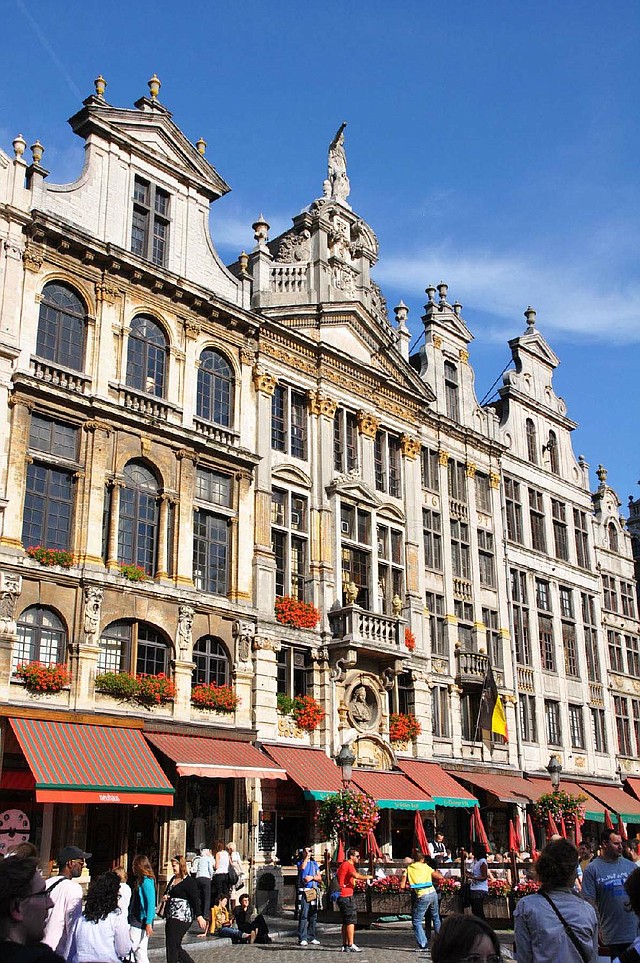Much more to European history than museums
The Grand Place, Brussels’ main square, is a beautiful blend of historic guild houses, public open space, and an ever-changing people scene.
Sunday, February 17, 2013
LITTLE ROCK — Europeans love to dress up the settings of everyday life, from their piazzas to their back lanes - and they’ve been doing it for centuries. Climbing the Acropolis, communing with the druids at Stonehenge, strolling the Croatian shore in the shadow of Emperor Diocletian’s palace in Split, tracing the intricate carvings on Trajan’s Column in Rome - the remnants of Europe’s distant past are everywhere you look.
But it’s not just that these historical remnants still exist that matters. What makes Europe so engaging is the way its citizens actively interact with their age-old surroundings.Take Brussels’ Grand Place, perhaps the grandest square in Europe. Sitting at the heart of the city, it’s ringed by splendid medieval guild halls. Any time of day, there’s something going on: concerts, flower markets, sound-and-light shows, and endless people-watching. Every other year, florists turn the square into a 19,000-squarefoot tapestry of flowers just because it feels good and looks pretty (and promotes the local begonia trade).
In London’s Trafalgar Square, the world’s biggest Corinthian column commemorates Admiral Horatio Nelson’s 1805 defeat of Napoleon’s navy, and assorted stern generals stand on pedestals around the square to honor England’s military glories. One pedestal, dubbed the Fourth Plinth, dates from the mid-19th century but never got a statue (the money ran out). But in a new take on memorializing sculpture, London’s art council has been commissioning witty temporary artworks for the plinth, such as a huge scale model of Nelson’s ship - in a bottle. Recently, 2,400 ordinary people took one-hour turns on top of the pedestal over a 100-day period - dressed as Godzilla, posed naked, impersonating Lord Nelson. A conversation between Londoners and their square, this is true public art.
In Europe, it’s not enough to look out and around as you walk about. Remember to also look up - or risk missing the gargoyles, plaques and fun architectural bits that decorate buildings. In Milan, shoppers in the glass-domed Galleria Vittorio Emanuele arcade are surrounded by mosaics and glass work that celebrate Italy’s unification (circa 1870). Subway riders in Paris pop out at old Metro stops decorated with sinuous Art Nouveau metalwork. The longest remaining stretch of the gray and ugly Berlin Wall (dubbed the East Side Gallery) was transformed over the years by artists from around the world.
I’m not suggesting that you ignore museum-quality art for street art. The things you’ll see in the Louvre, the Prado, or many other powerhouse European museums are more than worth your time and effort. But you’ll get an extra punch from seeking out artworks still in their original settings.
Take the great Venetian painter Titian, for example. If you visit Venice’s exquisite Frari Church, you can view two Titian altarpieces - and Titian’s tomb. This is art appreciation at its best, seeing the paintings surrounded by the altars, statuary and chapels of the very church where hundreds of years ago Titian figured out his approach to his commission. It’s the closest thing to a time-tunnel experience you can get in your travels.
The same applies to more recent artists. The paintings of the great Henri Matisse tell the history of early 20th-century art, but reveal less about the artist. For a deeper sense of the man and his faith, it’s worth entering the tiny Chapel of the Rosary in Vence (near Nice, in Southern France). You’ll be enveloped in a masterpiece of sacred art designed entirely by Matisse, from the stained-glass windows to the altar cloths.
Having Norwegian heritage, I’m partial to Oslo’s Frogner Park, a sculpture garden with 600 bronze and granite human figures that capture universal themes of the cycle of life - birth, childhood, romance, struggle, child-rearing, growing old and death. Designed by Norway’s greatest sculptor, Gustav Vigelan (from 1924 to 1943), the park is loved and respected by the people of Oslo: no police, no fences - and no graffiti.
In all these ways, “art” goes beyond a piece of painted canvas or sculpted marble. For me, it’s about artful living, and about a setting and my interaction with it. Think about a magical place like St. Mark’s Square in Venice. It’s special because of the sum of its parts: As the sun sets, and lantern lights are twinkling, you might turn your head and catch a glimpse of a beautiful statue. But now tune in the rest of your perceptions: listen as a cafe orchestra plays a tune, feel the cool breeze coming off the water, smell the nearby sea, savor the wine on your tongue. Engaging each of your senses is what the art experience is all about, whether you’re in or outside a museum.
Send e-mail to Rick Steves at [email protected]
Travel, Pages 55 on 02/17/2013
